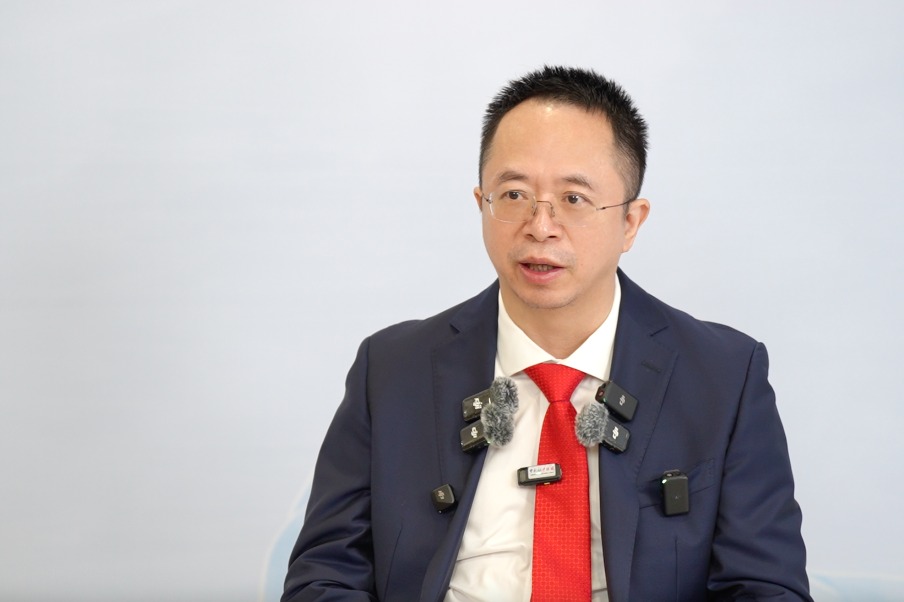'Crazy' idea highlights Chinese culture
Moving house to the US helps establish stronger foundations, literally, for ties between the two countries, Zhao Huanxin reports in Washington.

When John Flower first talked about his plan to dismantle and move a rural house in Southwest China's Yunnan province to West Virginia, in the United States, half a world away, Pamela Leonard, his wife, asked a simple question. "Are we crazy?"
After all, it is a house made of wood, stone and clay. It could not be attached to countless helium balloons and turned into a makeshift airship and flown away, like the character Carl Fredricksen did with his in the 2009 Disney/Pixar film Up.
It all started in 2014, when the couple began to work for the China Fieldwork Semester, an experimental education program run by Sidwell Friends School, a Quaker school in Washington.
Each spring, the program, based in Xizhou, a town with long history in Yunnan's Dali Bai autonomous prefecture, would bring dozens of 11th and 12th grade American students to experience cultural diversity and biodiversity in the province through tours, classes and do-it-yourself craftsmanship sessions.
Flower, a high school history teacher in Arlington, Virginia, says that he had always asked his students to do research projects on houses, which he sees as a type of walk-in library where they could learn how Chinese people live. The structure was shipped over in 2017.
Fast-forward to the summer this year, a group of Sidwell teenagers were finishing off a bathhouse and beginning a new project to build a traditional Chinese courtyard at the Friends Wilderness Center in Harpers Ferry, West Virginia, a 600-hectare nature reserve on the Shenandoah River.
The bathhouse and courtyard are all supporting structures to the two-story house that has been under construction since its parts arrived from China in late 2017 and is nearly finished.
"In a year or two, all the buildings and gardens and the courtyard walls will be built, and we can concentrate on our core mission as a cultural exchange center," Flower says.
For the farmhouse-turned-new house, Flower and his wife formed a nonprofit, the China Folk House Retreat.
It will serve as a living folk museum of Chinese rural life, provide a site of experiential learning with a school of traditional Chinese handicrafts, and teach the principles and practices of environmental sustainability with the house at its center.
For the Flowers, resettling the original house "from the Himalaya Mountains and Mekong River to the Blue Ridge Mountains and Shenandoah River" was not only the completion of a logistical feat, but also the beginning of a new passion and ambition.
Their encounter with the house in Yunnan was a result of their years of fascination with the traditional, rural, vernacular houses in China, which they believe are the "texts" of moral meaning, social relations and farming.
In 2014, Flower, director of Sidwell School's Chinese studies program, led his students to travel from Xizhou to Cizhong, a hamlet along the banks of the Lancang River, which is the upper reaches of the Mekong River, in Dechen county, sitting within northwest Yunnan.
While they were passing by a lone, two-story house, its owner Zhang Jianhua opened the gate and invited Flower and his team in for tea.
Zhang told Flower that his house was built in 1989, before electricity came to light the village.
The village had a power supply, but not during inclement weather, such as storms. The government planned to build a power station on the nearby Lancang River, and a new dam meant that river waters would flood large swathes of land, including that upon which Zhang's residence stood.
By August 2018, Zhang would have had to move to a house built for him by the local government about a kilometer away.
"Your house is so beautiful. It's a shame we can't just take it apart and bring it to America," Flower remembered telling Zhang.
Zhang, of Tibetan ethnicity, had, for two winters, logged wood for the home from the mountains by himself. Some logs were so huge that each one needed to be carried by four people. He hired Bai carpenters from neighboring Jianchuan county, a place renowned for craftsmanship in homebuilding and wood carving.
With the traditional layout, carving and joinery techniques going back centuries, the house is a blend of Tibetan, Naxi, Bai and Han ethnic styles. It is not unusual, but "unusually" well built and well maintained, Flower would later recall.
Flower noted that Zhang's house, like many other traditional farmhouses are, literally, texts, because they have lots of inscriptions, symbols and meaningful ornamentation — not just "decoration" — that reinforce traditional, usually Confucian, values or hold moral meaning.
"Perhaps (the) most important way in which a house is a reference of folk ways, though, is its function as an agricultural tool," he says.
For example, Zhang's house has a cool, dark, dry room on the western side of the first floor that served as an agricultural store room, providing the ideal conditions for holding grain and fermented foods.
The open attic was used for drying and storing hay and dried vegetables to feed animals in winter; the courtyard and porch were used for processing wine and hanging meat to cure.
"Wouldn't it be cool if, instead of taking students to China to see houses, we could take a Chinese house to the students?" Flower says.
In the early 1990s, in what seemed to be a honeymoon period for people-to-people exchanges between China and the US, both Flower and his wife were able to spend a few years in Sichuan province, which neighbors Yunnan.
Leonard was attached to the Bureau of Animal Husbandry, studying livestock development projects for her doctoral thesis.
She later helped create the China Fieldwork Program in Yunnan for Sidwell Friends School, where she taught landscape ecology.
Their stay in Sichuan and Yunnan provinces cemented their belief that houses could be an important medium for learning.
Between 2014 and 2017, Flower and his students paid a few visits to Zhang, who had agreed to sell the house at a nominal price. He also donated some everyday utensils to Flower.
Zhang said he would be glad if people elsewhere could see his house and the folk ways of the village.
In the summer, the house was dismantled but not before vital measurements and photos were taken, and all structural elements specifically marked.
Martin Fair, an architecture and construction enthusiast who owns a guitar-repair business in Virginia, recalls, "it was fascinating to see the different types of joinery used to build the house. I think the main skill I brought that was useful was bundling parts and stacking them up so they could be relocated without damage".
But never before had any piece of wood, newly logged or used, been shipped to the US out of Cizhong village, let alone whole sections of a house to be rebuilt elsewhere.
In addition to worrying about rain that may lead to muddy roads, Flower and his team had to deal with one problem after another: permits, drivers, customs clearances and shipping costs.
"I feel very grateful to all of the people we worked with. I'm relieved and grateful and tired, but happy," he said as two truckloads of house parts were sent to the Tianjin Port in North China to be shipped to Baltimore.
The house parts arrived in September 2017 and were then transferred to West Virginia.
Not surprisingly, Sidwell Friends School has sponsored experiential education programs at the house's new location.
Leonard, who serves as chief executive officer of the China Folk House Retreat, took charge of fundraising and camp preparations, and after forming a partnership with the Friends Wilderness Center and West Virginia Timber Framers Guild, the CFHR started its inaugural summer program in 2019.
In four weeks, about 25 students cleaned the wood, treated it for insects, and then began the rebuilding, starting with the gate house and its surrounding walls.
One of the walls was made using the traditional rammed earth method, and another was made using a wooden frame covered in "hempcrete" — a mixture of hemp (fiber), lime and clay — a "negative carbon", sustainable building material that was extensively used in Yunnan, according to Flower.
The following summer, a "quarantine pod" of a dozen students, including two students from Sidwell's sister schools in Beijing and Shanghai, worked for a month to build the surrounding hempcrete walls, enclosing the exterior of the house.
The 2021 program built the original kitchen and installed the interior walls of the house.
Flower says he is working with young people who would like rejoin the project annually — that connection to the younger generations is vital for the China Folk House to stay alive.
Melinda Daniels, 17, a senior at Sidwell, returned to the house-rebuilding program this summer after having worked on it the year before.
Every day, Daniels and her peers would arrive at the work site around 8 in the morning in order to beat the West Virginia heat, starting with a brief meeting to set out the day's goals and share announcements.
The volunteers would split into work teams such as bricklaying/rock crew, concrete crew, hempcrete crew, garden crew and wood crew.
"The volunteers work until lunchtime and then have scheduled Chinese/East Asian cultural activities — a volunteer may find themselves learning about Chinese medicine, practicing tai chi moves … or cooking a traditional dish like momo," she says.
Then, from the early evening, the volunteers and the interns are left to enjoy the beautiful West Virginia wilderness — swimming or canoeing in the Shenandoah River, or hiking.
Daniels says the CFHR has sparked in her a new interest in East Asian cultures, history and ways of life, and she hopes to minor in East Asian studies at a university, and then to visit Cizhong or do field work in China.
"I expect nothing more than to further understand the people and the region on a level that cannot be achieved with the noise of the US media or a political agenda," she says.
Martin Fair, Flower's friend who helped with the dismantling, says that all three of his sons were helping with the rebuilding and attending the summer camps, where they all were studying the Chinese language.
The Chinese Ambassador to the US Qin Gang visited the site in late June, joining students and volunteers in raising a wood frame and making a hempcrete wall. He drew inspiration from the joinery, which holds the wooden columns and other structures firmly together.
"In the face of the challenges, Chinese and American people are like the joinery. Individually it has limited strength, but we could play a huge role together by seeking common ground while shelving differences, enhancing exchange and ramping up cooperation, and make the house of China-US friendship more solid," he said.
Fair says he was very happy to be there for the Chinese ambassador's visit and was pleased that he showed support for the project.
"I think the continuing cultural exchange that happens there will bring many good things to our area and keep a door open between the Chinese and American people," he says.
Yang Wendou, who coordinates Flower's program in China and serves as a tour guide for US students, agrees.
"Yunnan is rich in its intangible cultural heritage, and US students participating in the China Fieldwork Semester are very interested in learning wood carving, dyeing, or silver smithery from rural masters," Yang says.
"Craftsmanship knows no borders. It would be great if carpenters from Yunnan and West Virginia could exchange their skills and talk about the culture behind them," he adds.
Flower says the house is helping create a whole China Folk House community. Even when the house is no longer meaningful to the local community or relevant to the youngsters, it can become a shelter, like a hostel, for hikers.
And then, when it is no longer useful as a shelter, it will at least return to nature.
Without lots of plastic and non-biodegradable building materials, its timbers and hempcrete will slowly return to the earth from which they came.
Houses are for people, and Flower says people-to-people relations are more important than ever.
"We fear and hate what we don't understand. When we can put a human face on an abstract idea like 'China' and understand that we all share the hope of living peaceful, happy lives and leaving a better world for our children, it's impossible to project our fears and hatred onto an 'other' that is as human as we are," he says.
"At CFHR, we are committed to letting all kinds of people from Yunnan, West Virginia and other parts of China and the US to come and get to know each other as people with common causes and shared dreams," he says.
Back in Cizhong, Zhang says he is glad that Flower has finally made it.
"I hope I can see the house someday," he says in a phone call from the village, which he notes now has a power supply in all weather.
"We'll be very happy to host him in his old house, and I think I'll simply tell him 'Welcome home!'" Flower says.
Like the fictional "clubhouse "from the film Up perched on the cliff overlooking Paradise Falls in South America, the China Folk House Retreat overlooking the Shenandoah River is a testimony to the realization of a crazy idea that not only makes a good story, but has plenty of tales yet to tell.
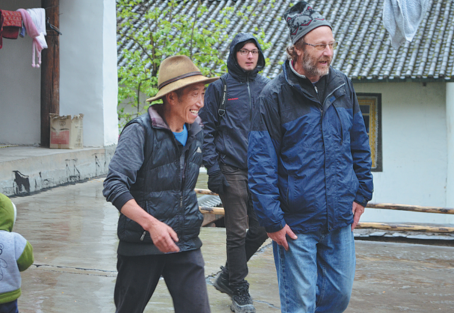
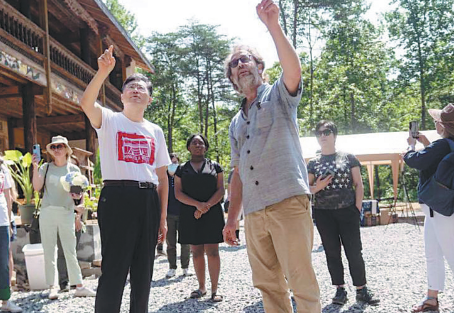
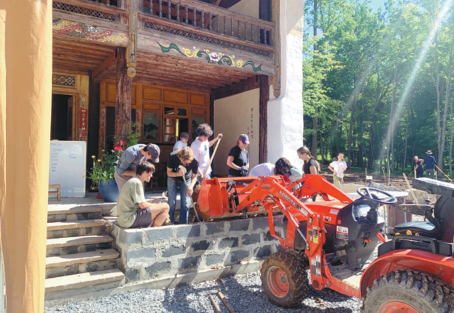
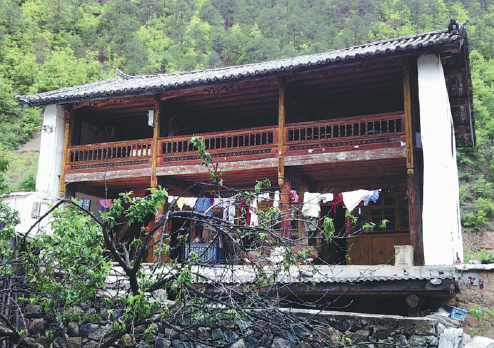
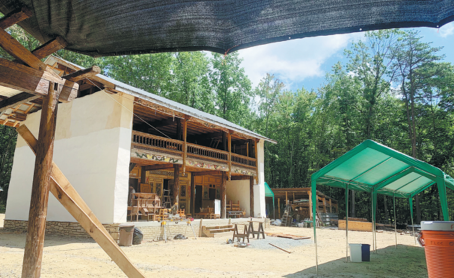
Today's Top News
- Navigating challenges in Sino-US trade ties: China Daily editorial
- China and EU should strive for dynamic equilibrium through shared development: China Daily editorial
- Xi extends condolences to Putin over plane crash in Russia
- What's behind Nvidia's charm offensive?
- Xi urges China and EU to strengthen bilateral relationship for a brighter future
- China's basic medical insurance covers 95% of population
















